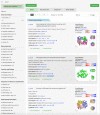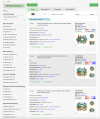Annotating Macromolecular Complexes in the Protein Data Bank: Improving the FAIRness of Structure Data
- PMID: 38040737
- PMCID: PMC10692154
- DOI: 10.1038/s41597-023-02778-9
Annotating Macromolecular Complexes in the Protein Data Bank: Improving the FAIRness of Structure Data
Abstract
Macromolecular complexes are essential functional units in nearly all cellular processes, and their atomic-level understanding is critical for elucidating and modulating molecular mechanisms. The Protein Data Bank (PDB) serves as the global repository for experimentally determined structures of macromolecules. Structural data in the PDB offer valuable insights into the dynamics, conformation, and functional states of biological assemblies. However, the current annotation practices lack standardised naming conventions for assemblies in the PDB, complicating the identification of instances representing the same assembly. In this study, we introduce a method leveraging resources external to PDB, such as the Complex Portal, UniProt and Gene Ontology, to describe assemblies and contextualise them within their biological settings accurately. Employing the proposed approach, we assigned standard names to over 90% of unique assemblies in the PDB and provided persistent identifiers for each assembly. This standardisation of assembly data enhances the PDB, facilitating a deeper understanding of macromolecular complexes. Furthermore, the data standardisation improves the PDB's FAIR attributes, fostering more effective basic and translational research and scientific education.
© 2023. The Author(s).
Conflict of interest statement
The authors declare no competing interests.
Figures








References
MeSH terms
Substances
Grants and funding
LinkOut - more resources
Full Text Sources

